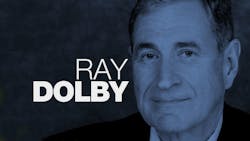What do the United Nations Educational, Scientific and Cultural Organization (UNESCO), Star Wars, and the San Francisco Opera have in common? The answer is simple—Ray Dolby, inventor of the technology that eliminates the hiss from analog tape sound. His company, Dolby Laboratories, has helped define the sound of everything from audio cassettes and movies to DVDs and digital TV.
In 1963, a two-year United Nations appointment to India led Dolby to what became the ubiquitous Dolby noise-reduction system. He was there as part of UNESCO to set up a scientific instrumentation laboratory for the Indian government. Dolby, who had an interest in sound since childhood and subsequently became interested in noise reduction, frequently carried a recorder with him.
Dolby developed his noise-reduction theory while recording traditional local music. The theory? As sound is recorded, pass it through a switchless, knobless encoder. Then play it back through a mirrorimage decoder, using new ideas to eliminate the side effects on the original sound incurred by other methods.
When his UNESCO assignment ended, Dolby headed to London to start Dolby Laboratories. His familiarity with and taste for England came when he earned a PhD in physics from Cambridge University in 1961. Soon after, Dolby introduced several concepts with his new noise-reduction technology.
First, Dolby only treated soft signals, leaving the loud signals that naturally mask noise unprocessed. Next, he divided the spectrum into multiple bands to prevent the noise modulation inherent in previous wideband systems. Quickly, Dolby Laboratories was associated with the anti-hiss process, and recording companies embraced it.
From cassettes to movies
Dolby can claim significant responsibility for the popularity of audiocassette tape players in the 1970s, thanks to a simpler variation of his noisereduction process called Dolby B. It used a single sliding band to accomplish the hiss reduction needed in the higher-frequency region of consumer recorders. Later, he created the more powerful Dolby C. He decided to license these technologies for consumer products and manufacture only professional products.
The movie industry quickly caught on. Dolby noise reduction was first used in preparing the soundtrack for 1971's A Clockwork Orange, and later on the soundtracks of movie release prints. That success led Dolby Laboratories into additional motion-picture technology developments.
Most notable was 1975's highly popular Dolby Stereo surroundsound. It derived high-fidelity, multichannel surroundsound from economical optical soundtracks, rather than the costly magnetic soundtrack format previously necessary (and very rarely used) for surroundsound in theaters.
High-fidelity surroundsound replaced low-fidelity mono, capturing the audience's ears in 1977's Star Wars and Close Encounters of the Third Kind. It brought the audience right into the picture—and into movie theaters with the Dolby Stereo.
Dolby Laboratories' next big development for movies was Dolby Digital 5.1-channel surroundsound, introduced with 1992's Batman Returns. Now, nearly every film has a Dolby Digital soundtrack. Dolby Digital 5.1 has migrated to consumer formats, including DVDs, HD TV, digital cable, and direct satellite broadcasts.
Today, Dolby Digital Plus offers higher quality at the low-bit rates needed for next-generation broadcasts. It also brings the option of higher bit rates for more channels of very high-quality audio for new disc formats, such as HD DVD and BluRay. Dolby Digital Plus already is approved for incorporation into an ATSC digital TV standard for robust mode transmission and as an optional format for both of the upcoming high-capacity video discs.
Dolby's company also is deeply involved in Internet file-transfer methods for music. Along with AT&T, the Fraunhofer Institute, and Sony, it codeveloped advanced audio coding (AAC), licensing the technology for applications like Apple iTunes music files and iPod music players. AAC offers higher quality for the same bit rate as MP3, or equivalent quality at lower bit rates.
Sound interest
Dolby's long history began with an interest in sound as a child. Born in Portland, Ore., in 1933, he played piano from the age of 10. He then learned the clarinet. The way the reeds vibrated and made sound fascinated him, but he didn't see a career in it. He wanted to be a cameraman, and he often practiced with his own projector and camera and became his high school's projectionist.
That's how he met Alex Poniatoff, founder of Ampex, the early developer of magnetic tape recording in the U.S. Poniatoff recognized Dolby's potential and invited the high-school student to work part-time for him. Dolby toiled through various positions. While he was in college, he developed the electronics for the first Ampex professional videotape recorder, the precursor of today's professional and consumer videotape systems.
Dolby went to Stanford University, where he received a BS in electrical engineering in 1957. Then he went on to Cambridge University as a Marshall Scholar for his doctorate. After the twoyear stint with UNESCO and establishing his company in London in 1965, Dolby moved his family and company's headquarters to San Francisco in 1976, where they remain today.
He holds more than 50 U.S. patents and has authored a litany of papers on videotape recording, long wavelength X-ray analysis, and noise reduction. He's garnered an Oscar, two Emmys, the National Medal of Technology, and even honorary membership in the Order of the British Empire. (See "Dolby Laboratories' Legacy" at www.elecdesign.com, Drill Deeper 11192.)
And the opera connection? That young piano and clarinet player is now on the boards of both the San Francisco Opera and the San Francisco Symphony.
